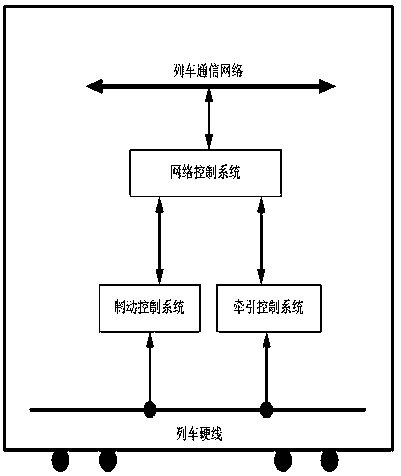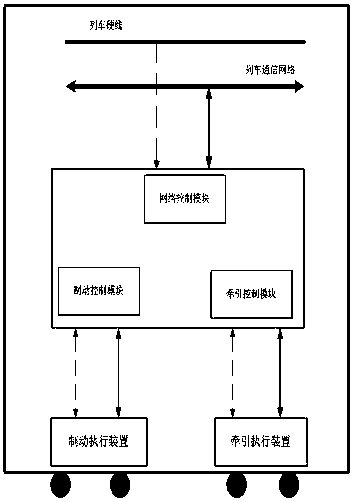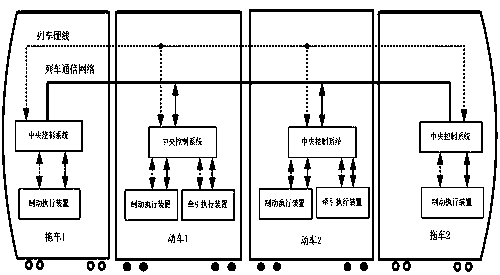Rail transit traction brake fusion control system and method applying the same
A technology that integrates control and rail transit. It is applied to electric braking systems, motor vehicles, electric vehicles, etc. It can solve problems such as affecting the accurate execution of braking commands, increasing system complexity, and increasing data transmission delays, reducing coupling. , the effect of avoiding data transmission and improving reliability
- Summary
- Abstract
- Description
- Claims
- Application Information
AI Technical Summary
Problems solved by technology
Method used
Image
Examples
Embodiment 1
[0053] Such as Figure 4 and 5 As shown, the present embodiment provides a rail transit traction braking fusion control system, including a central control system of a trailer and a pulling fusion control system of a bullet train; the central control system includes a central controller 6; the pulling fusion control system includes A traction fusion controller 1 integrating a traction control module and a braking control module, and a braking actuator 2 and a traction actuator 3 respectively connected to the traction fusion controller 1; 4 Receive the traction and braking commands sent by the central controller 6 or receive the traction and braking level commands sent by the controller from the train hard line 5, and then respectively control the actuators to perform traction and braking operations.
[0054] The working principle of this embodiment is as follows:
[0055] The central control system of the trailer with the driver controller, as the main control unit of the wh...
Embodiment 2
[0062] Such as Figure 6 As shown, the difference between this embodiment and Embodiment 1 is that the brake actuator 2 includes a bogie brake actuator; the traction actuator 3 includes a bogie traction actuator.
[0063] In this embodiment, the rack control mode is used to perform traction and braking operations.
[0064]The central controller 6 distributes the total force required for traction and braking to the diversion fusion controller 1 of each train according to the number of bogies through logical judgment and calculation, and the central controller 6 sends the braking command or braking level The command is sent to each pinning fusion controller 1, and the pinning fusion controller 1 sends the required air braking force to the bogie 1 brake actuator 21 of the brake actuator 2 and the bogie 2 brake actuator through the air brake control command Mechanism 22, and the brake actuator 21 of bogie 1 and the brake actuator 22 of bogie 2 respectively control the basic brake...
Embodiment 3
[0067] Such as Figure 7 As shown, the difference between this embodiment and Embodiment 1 is that the brake actuator 2 includes a brake actuator controller 20 and a bogie brake actuator; the traction actuator 3 includes a traction actuator controller 30 and Bogie traction actuator.
[0068] In this embodiment, the vehicle control mode is used to perform traction and braking operations.
[0069] According to logical judgment and calculation, the central controller 6 distributes the total force required for traction and braking to each train according to the number of trains through braking instructions or braking level instructions, and the fusion controller 1 receives the central controller 6 The brake instruction or brake level instruction sent sends the air brake control instruction to the brake execution controller 20 of the brake actuator 2, and the brake actuator controller 20 controls the brake actuator 21 and the brake actuator 21 of the bogie 1. The foundation brake...
PUM
 Login to View More
Login to View More Abstract
Description
Claims
Application Information
 Login to View More
Login to View More - R&D
- Intellectual Property
- Life Sciences
- Materials
- Tech Scout
- Unparalleled Data Quality
- Higher Quality Content
- 60% Fewer Hallucinations
Browse by: Latest US Patents, China's latest patents, Technical Efficacy Thesaurus, Application Domain, Technology Topic, Popular Technical Reports.
© 2025 PatSnap. All rights reserved.Legal|Privacy policy|Modern Slavery Act Transparency Statement|Sitemap|About US| Contact US: help@patsnap.com



